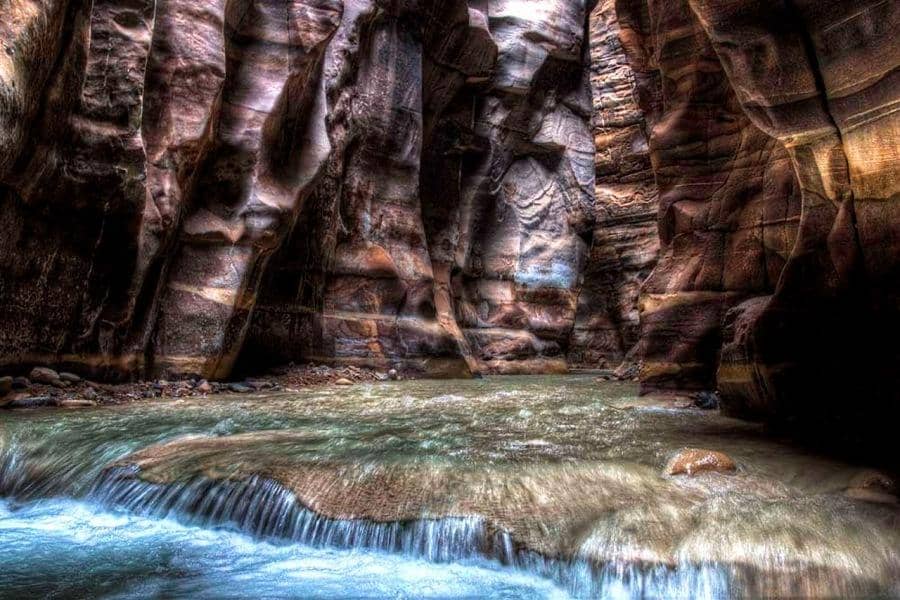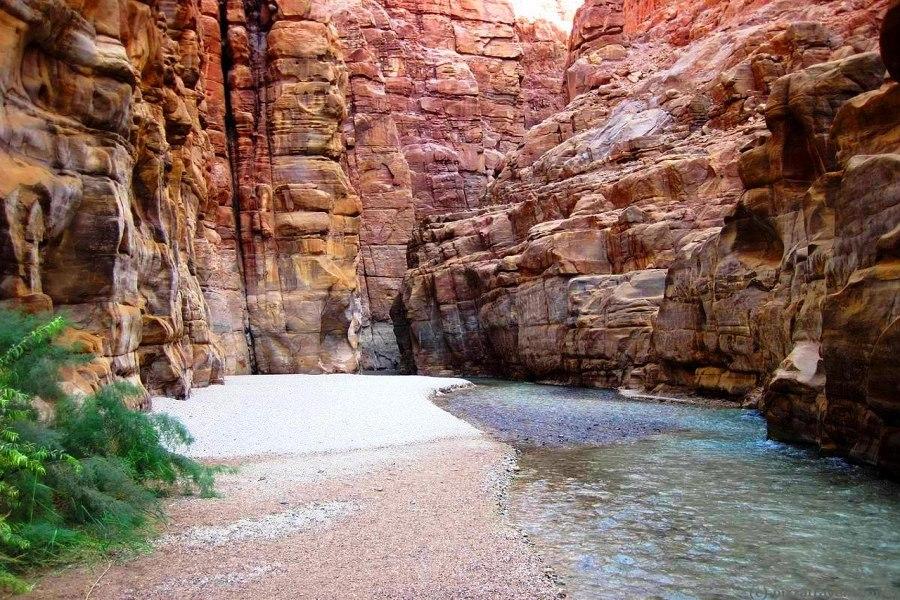+962 7 9635 8199
[email protected]
The lowest nature reserve on earth !
The 220 square kilometers reserve was created in 1987 by the Royal Society for the Conservation of Nature and is regionally and internationally important, particularly for the bird life that the reserve supports.
It extends to the Kerak and Madaba mountains to the north and south, reaching 900 meters above sea level in some places.
Wadi Mujib, historically known as Arnon, is a gorge in Jordan which enters the Dead Sea at 410 meters below sea level. The Mujib Reserve of Wadi Mujib is the lowest nature reserve in the world, located in the mountainous landscape to the east of the Dead Sea, approximately 90 km south of Amman. The reserve is located in the central highlands of the southern part of Jordan valley. The reserve includes a system of mountains and wadis extending from the rift valley escarpment to the Dead Sea Shores.
UNESCO World Heritage Site
Declaration Date: 2011
Location: Latitude 31.4997° or 31° 29′ 58.8″ north Longitude 35.6252° or 35° 37′ 30.8″ east.
Administrative authorities: The Royal Society for the Conservation of Nature – RSCN
Area (ha): The total area of the reserve is 21,200 ha
Core area(s): 12,817.52 ha
Buffer zone(s): 7,672.28 ha
Transition area(s): 710.2 ha


A large part of Central Jordan is drained by the Wadi Mujib (Wadi el-Mujib) basin. This river developed a deep canyon through the Moab plateau, the eastern shoulder of the Dead Sea Rift.
Intense subsidence of the base level at the Dead Sea is the main cause for the high rate of Pliocene/Pleistocene fluvial incision along the lower reaches of the Mujib basin.
During this phase of accelerated incision the wadis were submitted to the presence of a dense fault net in the canyon area.
The directions of the thalwegs correspond well with the apparent directions of the faults, indicating that fluvial incision occurred preferentially along tectonic lines characterized by rock weakness and discontinuity.
Major convex knickpoints along the longitudinal profiles are caused by normal fault movement or due to the delay in headward erosion with respect to the main or local base level. Minor knickpoints correspond usually to differences in rock resistance.
Climatic changes seem to be the principal cause for several types of Pleistocene deposits in the canyon but tectonic influence often played an additional role. Flash floods drive the principal incision events that result in effective erosion in the present dry semi-arid climate.
This 1,300 meter variation in elevation, combined with the valley’s year round water flow from seven tributaries, means that Wadi Mujib enjoys a magnificent biodiversity that is still being explored and documented today. Over 300 species of plants, 10 species of carnivores and numerous species of permanent and migratory birds have been recorded until this date. Some of the remote mountain and valley areas are difficult to reach, and thus offer safe havens for rare species of cats, goats and other mountain animals.
During the last Ice Age the water level of the Dead Sea reached 180 m below sea level, about 230 m higher than it is today. It flooded the lower areas of the canyons along its banks, which became bays and begun to accumulate sediments. As the climatic conditions changed, about 20,000 years ago, the water level of the lake dropped, leaving the re-emergent canyons blocked with lake marl. Most canyons managed to cut through their plugged outlets and to resume their lower courses. However, Wadi Mujib, the biblical Arnon River, abandoned its former outlet by breaking through a cleft in the sandstone. This narrow cleft became the bottleneck of an enormously large drainage basin with a huge discharge. During the years the cleft was scoured deeper and the gorge of Wadi Mujib was formed.


The Wadi Mujib reserve in Wadi Al Mujib consists of mountainous, rocky, and sparsely vegetated desert (up to 800 m), with cliffs, gorges and deep wadis cutting through plateaus. Perennial, spring-fed streams flow down the wadis to the shores of the Dead Sea which lies 400 m below sea-level.
The slopes of the mountainous land are very sparsely vegetated, with a steppe-type vegetation on plateaus. Groundwater seepage does occur in places along the Dead Sea shore, for example at the hot springs of Zara, which support a luxuriant thicket of Acacia, Tamarix, Phoenix and Nerium, and a small marsh. The less severe slopes of the reserve are used by pastoralists for the grazing of sheep and goats.
The hot springs of Hammamat Ma’in lie close to the borders of the reserve are heavily used for tourism/recreation.
A large dam was recently finished at the bottom of the wadi, where the modern road crosses the river. As a result, a large lake has formed. Today, Wadi Al Mujib is fed by seven tributaries.
As well as resident birds, the reserve is strategically important as a safe stop-over for the huge number of birds which fly annually along the rift valley between Africa & northeast Europe.
Most places in Jordan offer opportunities for bird watching and with major shifts in landscape and nature within short distances, there is much diversity as you move around the country. However, there are a number of key sites for bird watching that together host a wide cross- section of the country’s breeding and migrant birds. The bird-watching sites presented here are easily accessible and represent the main habitat types found in Jordan.
Download : BIRD-WATCHING IN JORDAN BROCHURE
WHERE BIRDS FROM THREE CONTINENTS CONVERGE
Discover the boundless opportunities for adventure that lie within the embrace of Wadi Al Mujib .

A. Local Communities living within the reserve: A small number of Azazmeh Bedouin live permanently in the area. They contribute to the general problem of the grazing and tree cutting. But they do not have traditional rights to the area. Total number of inhabitants who live permanently or seasonally in the transition area is around 400. The main economy for these inhabitants is livestock raising. The other communities living in the reserve and using it for grazing are the villagers who live in the surrounding villages. These villagers are living in the reserve (in the buffer zone) during winter and spring and the total number is around 300 inhabitants. These people depend mainly on grazing and farming activities for their livelihood. The last group living permanently in the core area of the reserve is the reserve rangers. These rangers are responsible for enforcing the reserve procedures systems through conducting patrol visits and monitor any environmental violation.
B. Immediate hinterland of the reserve: The reserve is located within two Governorates: Madaba and Kerak. A population of 128,495 inhabits Madaba. While the later is inhabited by 202,570. Both Governorates constitute 6.57% of the total population of Jordan. A cluster of villages surrounds the reserve location with a total population of 14, 319.
The reserve including all zones was established by the Prime Ministerial decree, following cabinet approval (number 4/62/13268) on the 9th of November 1985 and allocated to the RSCN for management from the Ministry of Agriculture through the Forestry Department, for the Prime minister letter in Arabic with an English translation.